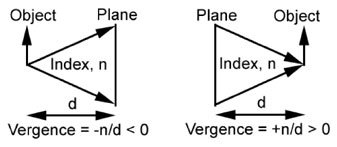Optipedia • SPIE Press books opened for your reference.
Explanation of vergence - Field Guide to Visual and Ophthalmic Optics
Excerpt from Field Guide to Visual and Ophthalmic Optics
Vergence is a concept in ophthalmic optics in which distances are converted to a dioptric power. Vergence is defined as

where d is the absolute distance between an object and a plane of interest, and n is the refractive index of the space. By convention, converging light has a positive vergence and diverging light has a negative vergence. Zero vergence occurs when the object is at infinity. Vergence is in units of diopters for d in meters.

Based on vergence, the lens formula is

where U is the object vergence, φ is power of the lens, and V is image vergence. For a thin lens, the plane of interest for both vergences is at the lens. For thick lenses, the planes of interest are the front and rear principal planes. The magnification is U / V.
| Object Vergence (D) | Distance |
| –0.25 | 4 m |
| –0.50 | 2 m |
| –1.00 | 1 m |
| –2.00 | 50 cm |
| –3.00 | 33 cm |
| –4.00 | 25 cm |
| –5.00 | 20 cm |
| –6.00 | 16.6 cm |
| –7.00 | 14.2 cm |
| –8.00 | 12.5 cm |
| –9.00 | 11.1 cm |
| –10.00 | 10 cm |
J. Schwiegerling, Field Guide to Visual and Ophthalmic Optics, SPIE Press, Bellingham, WA (2004).
View SPIE terms of use.

